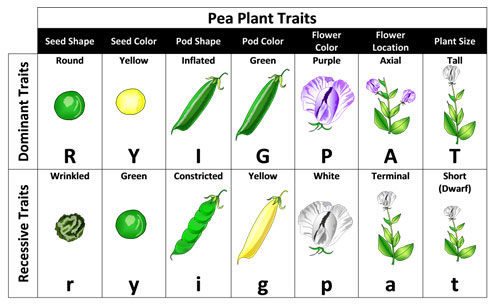
Mendel noticed that when he crossed a true breeding plant with one characteristic, such as purple flowers, with a true breeding plant with the opposite characteristic, such as white flowers, one trait hid or masked the other characteristic.

Mendel concluded that there must be two forms of the same gene for each trait he studied. Different forms of the same gene are called alleles. When one trait is “stronger” than the other trait, the “stronger” trait is called dominant trait or allele, and the one that is hidden is called the recessive trait or allele.
A capital letter is used to represent the dominant form of an allele or gene, and a lower case letter is used to represent the recessive form of the allele. In general, the first letter of the dominant trait is used to determine the symbol. For example, in pea plants, tall is the dominant trait for plant height, so T would be used for tall and t for short.
The traits that Mendel studied would use the letter system as shown in the chart below.

Source: Pea Plant Characteristics, Mariana Ruiz, Wikimedia Commons
When biologists describe the traits of an organism, they are refereeing to the organism’s phenotype. For example, for seed color, a pea plant can display a phenotype of yellow or green.
The genotype is the actual gene makeup of an organism. In other words, what forms of the alleles of a gene it contains. An organism could have the following genotypes:
| Forms of alleles | Example | Genotype | Phenotype Expressed |
| two dominant alleles (two capital letters) |
TT | homozygous dominant | dominant trait |
| two recessive alleles (two lowercase letters) |
tt | homozygous recessive | recessive trait |
| one dominant and one recessive allele (one capital and one lower case) |
Tt | heterozygous or hybrid | dominant trait |
In previous sections, you learned that the plants that Mendel called true breeding were homozygous dominant and homozygous recessive. In the diagram below, the phenotype is shown in purple and the genotype is shown in green.
